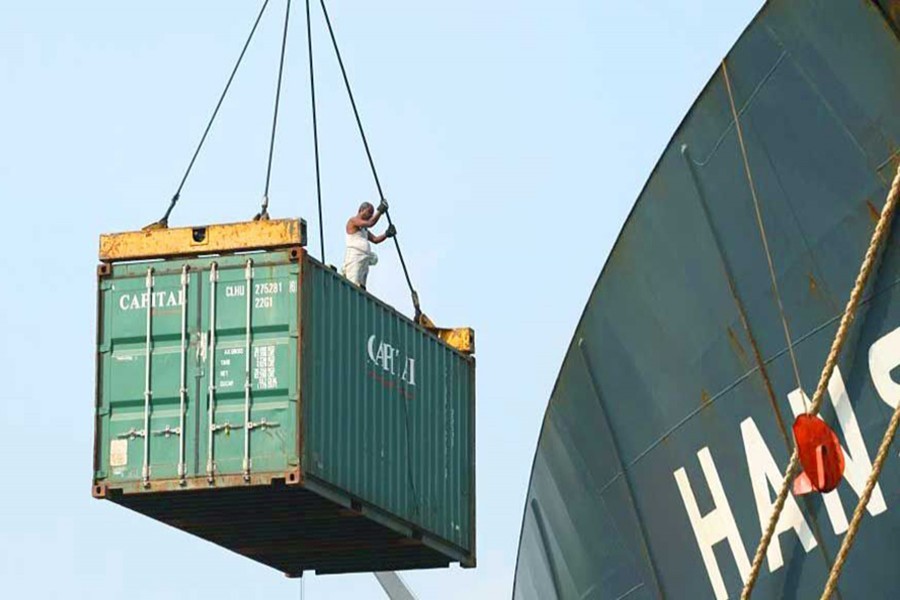Dhaka cautiously weighs export, revenue losses
Look before you leap into vast bloc RCEP: Experts

Published :
Updated :

Experts have cautioned that Bangladesh's exports might shrink and industries suffer setbacks if the country joins a new free-trading bloc called RCEP, unless its privileged market access is secured.
A recent high-profile meeting was told that the exports to many of the Regional Comprehensive Economic Partnership (RCEP) countries could fall in the range between 9.0 per cent and 31 per cent unless preferential market-access facilities are available during post-graduation era.
These countries and probable export losses are: Japan 30.53 per cent, South Korea 27.53, New Zealand 11 per cent, Australia 11 per cent, Thailand 8.93 per cent and China 8.29 per cent, according to sources.
Keeping this prospect in view, the meeting suggested assessment of all possible aspects and challenges before joining in the vast economic bloc.
The Ministry of Commerce convened the meeting, as part of doing homework ahead of negotiations, to review possible benefits and risks of joining the China-backed economic grouping-the latest of a numerous blocs proposed or in the making in the region and beyond lately.
Besides, a good number of country's industrial units may be hurt, save apparel, beverages and tobacco, according to the views elicited from the meeting.
However, investment volume will increase, by an estimated 3.36 per cent, and that might create a positive impact on bilateral trade with RCEP member-nations as it is a Mega Regional Trade Agreement (RTA).
Before accession into the RCEP, Bangladesh has decided to further review the possibilities and challenges in terms of industrial capacity, overall revenue risk, investment potential, service sector, regional value chain and e-commerce, according to the meeting minutes.
It has also decided to take political guidance regarding the initiation of the accession process of Bangladesh into the world's largest alliance.
Bangladesh has decided to look into the inclusion process of Hong Kong and Macau into RCEP as they have applied recently for joining it.
The meeting discussed the necessity of a study on what will be the market access of Bangladeshi potential products and how much investment may come into Bangladesh from the RCEP countries.
The RCEP, which came into being in January 2022, is a free-trade agreement (FTA) between the ten member-states of the Association of Southeast Asian Nations (ASEAN) and the others.
The ASEAN members are Brunei, Cambodia, Indonesia, Laos, Malaysia, Myanmar, the Philippines, Singapore, Thailand and Vietnam and its five FTA partners are Australia, China, Japan, New Zealand and the Republic of Korea.
Being the world's largest free-trade turf, the 15 RCEP-participating countries account for almost half the world population and contribute about 30 per cent to global GDP and over a quarter to world exports.
A recent Bangladesh Trade and Tariff Commission (BTTC) study mentioned that the Asia-Pacific bloc represents 2.3 billion inhabitants, contributes US$25.8 trillion or about 30 per cent of global GDP, and accounts for $12.7 trillion or over a quarter of global trade in goods and services, and 31 per cent of global foreign direct investment (FDI) inflows.
The volume of export of Bangladeshi goods in the area stood at $3.9 billion and imported goods worth $24.5 billion in the fiscal year (FY) 2020-21. On the other hand, at the same time, the volume of services export was $1.8 billion and import worth $2.6 billion in the same period.
Bangladesh currently gets preferential market facility in many of the RCEP countries in the form of preferential trade agreement (PTA) or GSP facilities.
Many developed countries would not provide duty-free facilities to Bangladesh after its graduation from the LDC status in 2026 and get exposed to open competition in its external trade after 2029.
The study mentions RCEP includes some of the major export destinations as well as major import sources of Bangladesh. Considering the bilateral-trade scenario, RCEP remains more as an important partner from the Bangladesh perspective.
Imports from RCEP contribute around 43.92 per cent of the total global imports of Bangladesh, 55.33 per cent of the total tax revenue and 58.56 per cent of total revenue from customs duty collected under home consumption, as of FY 2020-21.
Since some major import sources of Bangladesh, like China, Japan, Thailand, South Korea, Indonesia, Malaysia and Australia, are involved with RCEP, there is a threat of losing certain amount of revenue from these countries.
More than 68 per cent of total merchandise exports to RCEP are under apparel-product category. Top twenty export items to RCEP mostly consist of apparel products and these twenty products constitute 64 per cent of total export items.
It says the probable increase in import along with a comparatively protective regime of Bangladesh estimated a probable high revenue loss for Bangladesh compared to that of the RCEP.
"We are working on RCEP-joining issue--it will take time to start negotiation," a senior official of the commerce ministry said.
Echoing the same tone imminent economist Prof Mustafizur Rahman says the government should conduct study on the pros and cons prior to joining the RCEP.
"Since various issues, including investment, services, trade and communications etc are related with the joining of such bloc, a thorough study is necessary to this effect," adds Prof Rahman, distinguished fellow at the Centre for Policy Dialogue (CPD).
He noted that Bangladesh would be enjoying preferential market access to various countries for certain time after its LDC graduation.
"So if we join the bloc immediately, it might narrow down such opportunities."


 For all latest news, follow The Financial Express Google News channel.
For all latest news, follow The Financial Express Google News channel.